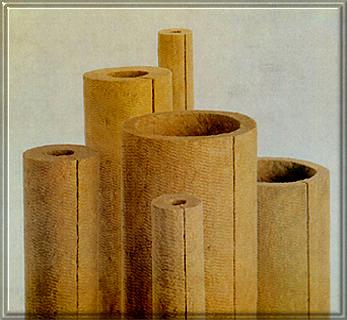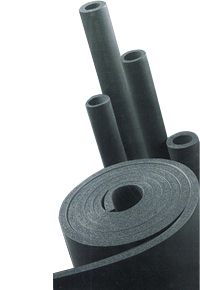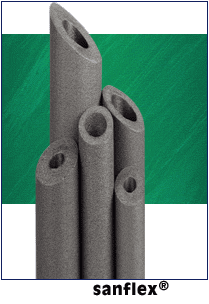|
Benefits of Commercial and Industrial Insulation
Conserves Energy by Reducing Heat Loss or Gain
Properly designed and installed insulation systems immediately
reduce the need for energy, a costly ingredient of every product
made.
Controls Surface Temperatures for Personnel Protection and Comfort
Insulation reduces the surface temperature of piping or equipment
to a safer level, resulting in increased worker safety and the
avoidance of worker downtime due to injury.
Facilitates Process Temperature Control
By reducing heat loss or gain, insulation can help maintain the
process temperature to a pre-determined value. Insulation thickness
must be sufficient to limit the heat loss in a dynamic system
or limit the temperature drop, with time, in a static system.
Prevents Condensation on Cold Surfaces
Specifying sufficient insulation thickness with a good vapor retarder
is the most effective means of controlling condensation and limiting
corrosion on cold piping, ducts, chillers and roof drains. Sufficient
thickness is needed to keep the surface temperature above the
dewpoint temperature of the ambient air.
Prevents or Reduces Damage to Equipment From Exposure to Fire
or Corrosive Atmospheres
When used in combination with other materials, fiber glass and
rock and slag wool insulation help provide fire protection in
firestop systems; grease- and air-duct fireproofing; and electrical
and communications conduit and cable protection.
Controls Noise
Special or standard insulation materials can be used to encase
or enclose a noise generating source, forming a sound barrier
between the source and the surrounding area. Insulation installed
in walls and ceilings can provide a barrier to the entry of sound
from the outside or other rooms. Click here for literature on
noise control.
Frost Protection Systems
Heat tracing can be used to protect exposed pipework from freezing.
The most common usage is to ensure prevention of freezing of pipework
for water services. However the term frost protection more widely
referes to maintain pipe contents at temperatures to stoped the
contents solidifying.
| Fiber Glass Pipe Insulation
Fiber glass pipe insulation is a molded, heavy density,
one piece insulation made from inorganic glass fibers bonded
with a thermosetting resin. It is produced in 3’ lengths
with or without a jacket. It is used on mechanical and process
piping in power, process and industrial applications, and
in commercial and institutional buildings. Most fiber glass
pipe insulations can be used on systems from 0º to
1000º F. |
 |
| |
Rock Wool Pipe Insulation
Rock wool (or mineral wool) pipe insulations are precision
cut pipe coverings composed of high density mineral wool.
It can be used in a wide range of applications for hot and
cold piping ranging from –120ºF to 1200º F.
This product is frequently used in high temperature industrial
process power plants, power stations, petrochemical complexes,
etc for steam and process pipe work – and for commercial
hot/cold water systems. It is produced in two half cylinders
and can be supplied either plain or with a FSK type facings.
It comes in 3’ lengths in pipe sizes from 1/2"
IPS to 20" IPS. |
 |
| |
|
Elastomeric Pipe Insulation
HFoamed resins combined with elastomers produce a flexible
cellular material. Available in pre-formed shapes and sheets,
elastomeric insulations possess good cutting characteristics
and low water and vapor permeability. The upper temperature
limit is 104.4ºC (220ºF). Elastomeric insulation
is cost efficient for low temperature applications with
no jacketing necessary. Resiliency is high. Consideration
should be made for fire retardancy of the material.
.The easiest and quickest method to insulate already existing
pipework is to use elastomeric (nitrile rubber) insulation
material. This highly flexible non-fibrous insulation material
makes safe application easy, especially in areas of limited
available working space.
Elastomeric insulation’s biggest asset is its excellent
thermal efficiency
|
 |
|
|
Foamed Plastic
Insulation produced from foaming plastic resins create predominately
closed-cellular rigid materials. "K" values decline
after initial use as the gas trapped within the cellular structure
is eventually replaced by air. Check manufacturers' data.
Foamed plastics are light weight with excellent moisture resistance
and cutting characteristics. The chemical content varies with
each manufacturer. Available in pre-formed shapes and boards,
foamed plastics are generally used in the low and lower intermediate
service temperature range -182.8ºC to 148.9ºC (-297ºF
to 300ºF). Consideration should be made for fire retardancy
of the material.
|
 |
The temperature range within which the term
"thermal insulation" will apply, is from -73.3ºC
(-100ºF) to 815.6ºC (1500ºF). All applications
below -73.3ºC (-100ºF) are termed "cryogenic,"
and those above 815.6ºC (1500ºF) are termed "refractory."
Thermal insulation is further divided into three general
application temperature ranges as follows:
A. Low Temperature Thermal Insulation
1. 15.6ºC through 0ºC (60ºF through 32ºF)
-- i.e. Cold or chilled water.
2. -0.6ºC through -39.4ºC (31ºF through -39ºF)
-- i.e. Refrigeration or glycol.
3. -40.0ºC through -73.3ºC (-40ºF through
-100ºF) -- i. e. Refrigeration or brine.
4. -73.9ºC through -267.8ºC (-101ºF through
-450ºF) -- i. e. cryogenic.
B. Intermediate Temperature Thermal Insulation
1. 16.1ºC through 99.4ºC (61ºF through 211ºF)
-- i.e. Hot water and steam condensate.
2. 100.0ºC through 315.6ºC (212ºF through
600ºF) -- i.e. Steam, high temperature hot water.
C. High Temperature Thermal Insulation
1. 316.1ºC through 815.6ºC (601ºF through
1500ºF) -- i.e. Turbines, breechings, stacks, exhausts,
incinerators, boilers. |
| |
|
| Pipe Insulation
Schedule |
|
| |
|

